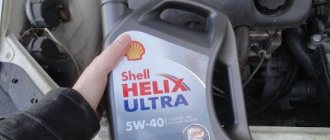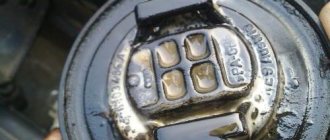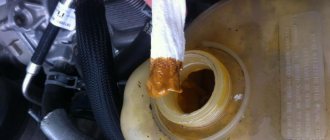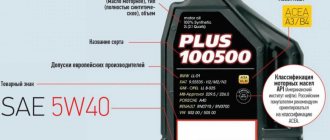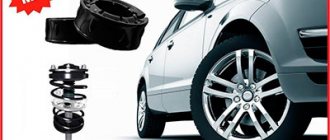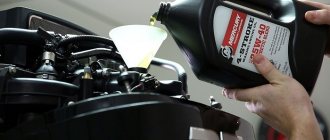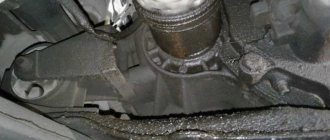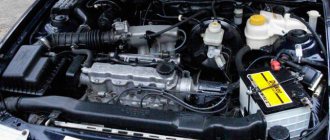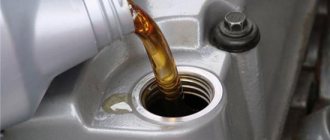If the antifreeze level decreases, but no liquid leaks are noticed from the outside, it means that it is getting into the engine lubricant. The fact that antifreeze goes into the oil is a bad thing, since a loss of lubricating properties occurs, the load on the engine increases, which leads to its failure. This is facilitated by one of the components of antifreeze - glycol. Its chemical properties provoke the formation of an ever-growing potential, which blocks the quality characteristics of the oil.
The appearance of antifreeze in oil: what are the signs?
The first thing a motorist should be concerned about when he notices that the coolant is decreasing is where it accumulates or where it ends up. Of course, if there are no obvious signs of antifreeze leaking under the vehicle (it is dry underneath), but the liquid disappears, then you should pay attention to signs that show that antifreeze is getting into the oil. The presence of the following signs allows you to quickly determine why the coolant level changes sharply.
- Antifreeze is visible on the oil level dipstick
The engine runs unevenly when idling. The car is getting damaged.
- When checking the oil level, the dipstick showed drops of antifreeze.
- The upper liquid level quickly tends to the minimum.
- Detection of unusual antifreeze drips under the head.
- At high speeds, air bubbles are observed in the expansion tank.
- Oil streaks are visually visible on the outer wall of the expansion tank.
- Traces of coolant are visible on the crankcase.
- Change in color of antifreeze. Over several months it becomes significantly darker and fades, even to black.
- When examining the spark plugs and their seating grooves, traces of coolant are found.
- Increased exhaust concentration - carbon monoxide in the expansion tank exceeds the permissible content.
- Coolant accumulates in the pan.
Car oil in antifreeze
The opposite also happens. When motorists see traces of grease on the walls of the expansion tank, they ask themselves the question: “Why is there oil in the antifreeze?”
The car oil from the lubricating complex somehow ends up in the cooling system, but everything is fine with the oil liquid. Its volume, shade, viscosity do not change.
Experienced drivers in such situations say: “The end of the cylinder block.” Usually these words are true. Through a crack in the block, part of the lubricant enters the cooling complex and curls up there. An emulsion is formed.
It is almost impossible to replace the cylinder block on your own. You must contact a specialized service center.
Briefly about the reasons for antifreeze getting into the engine oil
Microcracks in cylinder head
Experienced drivers will immediately be able to point out the reason why there is antifreeze in the oil, but everything is not as simple as it might seem at first glance. The first thing they talk about is the cylinder head. First of all, this is gasket burnout. Such a breakdown is directed either to the external environment outside the block, or inside it. When a burnout occurs in the direction of the engine compartment, it is immediately visible from the drip. In addition, there are a number of other reasons why oil gets into the antifreeze, such as:
- Microcrack in the cylinder block
- Deformation of the head, which is caused by overheating, long-term operation or overtightening of the bolts.
- Corrosion phenomena in cylinder liners.
All these problems can be eliminated with the help of car services, turners, boring machines, and milling machines. It is important to know that if the gasket burns out from inside the block, then it is much more difficult to determine such a malfunction. In order to detect this breakdown, be sure to inspect the car every day and pay attention to the slightest changes in its operation.
Antifreeze found in oil in time will not cause serious consequences. That is why it is so important to carry out a daily visual inspection of all accessible units and systematically service the machine from a specialist.
Why does coolant get into the car oil?
The reasons why antifreeze went into the oil may be the following:
- The cover is burnt out. Between the cylinder head and the cylinders there is a metal lining. High temperatures in the combustion chamber and cooler increase the wear of this spare part. If you operate the car correctly, the lining will last approximately one hundred thousand kilometers. However, if the part is constantly overheated or filled with low-quality coolant, the part becomes deformed and the coolant goes into the lubricant.
- Cracks. While running, the engine heats up and cools down. This causes the metal to crack. Through the cracks, the coolant enters the lubricant complex. The negative impact increases if you start the engine in low temperature conditions.
- The block head was deformed. This problem appears after repairing the motor (if the head was removed). In view of this, major repairs should be entrusted to specialists.
- Defective pad. Even among new spare parts there are low-quality products. Replacing a part with a defective one will definitely not fix the problem.
Buy spare parts only from reliable retail outlets. Do not use the services of car services that employ employees whose qualifications are questionable.
We recommend reading: Where does the VAZ 2114 antifreeze go?
Oil cooler failure
An oil cooling system is necessary for a car to maintain the lubricant at a temperature that is comfortable for the car to operate. If the oil cooler tubes are damaged and this system depressurizes, oil gradually begins to leak into the coolant. The first signal that the problem with your breakdown is in the oil cooler is the appearance of oil with bubbles in the coolant.
In this case, it is necessary to remove the pipes from the oil cooler, wash them and connect them together. The expansion tank of the system also needs to be completely cleaned. After these manipulations, the liquid is refilled. After a short period of time after restarting the car, you need to check whether the problem has disappeared or not. If yes, then the repair will cost you a little less, since you will have to deal exclusively with the cooler.
The coolant reservoir is dirty with grease
After removing the cooling system, you should thoroughly check all the pipes and, if there are cracks, weld them. This part of the work should be left to professionals. Poor quality repairs will end up costing you even more. Most often, copper tubes of the appropriate diameter are simply inserted into the places where cracks form in the oil cooler.
Sometimes oil gets into the antifreeze due to the fault of service station employees. If you discovered such a problem after visiting the station, it is worth checking whether engine oil has been added to the cooling system of your car. To do this, the liquid from the oil cooler is completely drained, and the system itself is thoroughly washed. In the final part of the work, you just need to pour new antifreeze into the engine.
Be sure to note that passenger cars have an oil heat exchanger filter. If a malfunction of the engine circuit in question is diagnosed, the filter must also be replaced.
What to do
The method for eliminating an antifreeze leak depends on the cause of its occurrence. The simplest situation is a burnout or rupture of the gasket. It cannot be repaired, so the gasket should be replaced.
If a deformation of the cylinder head occurs, most often you cannot do without the help of a specialist, since performing this action incorrectly will lead to failure of the part. A deformed cylinder head will require grinding on a special machine. But if the defects are serious, it is necessary to remove more than the permissible layer. In this case, the part will have to be replaced.
We recommend: Fuel filter: description, types, replacement, device, photo, video.
The discovery of a large crack in the cylinder block requires its immediate replacement. Small cracks in cast iron or silumin blocks can be repaired by welding - electric or “cold”.
Replacing the BC gasket with your own hands
Replacing the cylinder block gasket is a simple manipulation, and any car owner can easily cope with this task on his own. The main condition for obtaining the desired result without additional breakdowns is to follow the car manufacturer’s recommendations regarding the strength and procedure for tightening the cylinder head with a torque wrench. The sequence of actions when replacing the gasket is as follows.
- The car is de-energized by removing the negative terminals of the battery. If necessary, drain the antifreeze and reduce the pressure in the supply.
- First, the attachments are disconnected from the cylinder block. If you have no experience working with parts, it is advisable to sketch or otherwise record the sequence of dismantling the elements. Craftsmen advise arming yourself with a marker and applying the appropriate marks to each dismantled part.
- The screws securing the cylinder head begin to unscrew from the center, making half a turn each time.
- Disconnect the cylinder head and remove the old gasket.
- Clean the cylinder head and wash it with gasoline.
- Install a new gasket. To ensure precise installation, there are special bushings on the center of the block. The hole for the oil passage should be between the 3rd and 4th cylinders.
- Screw all parts in reverse order.
- Return hanging elements to their place
IMPORTANT! The fastening bolts must be cleaned before unscrewing. This will prevent the key from falling off and protect the bolt splines from damage.
Repairing a cylinder crack
The most common way to seal a BC crack is welding. The work requires certain skills and abilities, since a violation of the technology will lead to divergence of the seam, and the problem will return. The welding sequence and technology is as follows:
- The ends of the crack on the block are drilled at an angle of 90 degrees. This procedure is necessary to prevent further expansion of the crack.
- The cylinder block is heated to 650 degrees. Then a cast-iron-copper filler wire is applied to the crack and a continuous weld is made using flux.
- The part is gradually cooled in a heating cabinet. Sudden cooling of the cylinder block after welding is unacceptable: this will lead to rupture of the seam and complete failure of the part.
The seam on the part can be made without heating, using electric welding and copper electrodes in a tin wrapper. In this case, the resulting seam requires additional reinforcement with epoxy resin. The surface is degreased with acetone or a special compound, then a layer of epoxy paste is applied to the seam with a spatula. After this, the BC is dried for 24 hours at room temperature. After drying, the seam is sanded.
We recommend: When should you change the oil in a manual transmission?
Minor cracks can be repaired without welding by applying fiberglass and epoxy resin. The surface of the crack is degreased, then several layers of fiberglass are applied one by one, each coated with epoxy paste.
What consequences might a violation have?
Oil getting into the refrigerant is very unpleasant. The consequences of such a violation can be very serious. In the future, serious repairs will be required and you will have to spend a lot of time restoring the car’s functionality. The consequences of a violation include:
- rapid and complete wear of bearings;
- motor jamming. Such a breakdown is often observed in diesel engines;
- oil filter contamination.
When mixing oil with antifreeze, a reaction occurs between the substances. Corrosion appears in the motor, and the bearings begin to rub against other parts. A serious load on all elements of the system leads to rapid breakdown of the vehicle. Soot can settle on the parts, which later gets into the filter, which also leads to breakdown. You can’t drive such a car, but it’s better to get it repaired as quickly as possible.
Methods for detecting oil and antifreeze leaks
Let's look at the most common signs of oil and antifreeze leaks:
Read also: Use of tansy for parasites
- thick white smoke from the exhaust pipe,
- sticky, “mayonnaise” consistency deposits on the oil filter,
- change in oil color on the dipstick or coolant in the tank,
- breakdown of the cylinder head gasket (the gasket needs to be replaced and the block repaired),
- corrosion of cylinder liners (you need to install new liners and turn the block),
- decrease in coolant level.
Thick white smoke from the exhaust pipe
Sometimes it is necessary to measure the amount of refrigerant that leaves the system and check the oil level on the dipstick. If the losses are insignificant, perhaps the reason is quite simple and lies in microcracks in the hoses and pipes; leakage at the connection points of the line or slight leakage in the heat exchanger.
What to do if there is antifreeze in the oil
What action should you take if antifreeze is mixed with engine oil? The answer to this question depends on the reason that caused this malfunction. We list the actions in the same order in which the above reasons were listed.
- Failure of the cylinder head gasket . In this case, it is necessary to replace the gasket itself. To do this, you need to dismantle the block head. During installation, it is important to be careful to carefully place the gasket in its seat. The second important nuance is that it is very advisable to use a torque wrench when tightening the mounting bolts. You cannot tighten them “by eye”, since there is a high risk of exceeding the tightening torque, which will lead to damage to the gasket and its premature failure. The value of the clamping torques and the bolt tightening sequence are given in the technical documentation of the repair manual for a specific car model.
- Violation of the geometry of the block head . In particular, as a result of overheating or other mechanical damage, the cylinder head can occasionally “lead”, that is, its lower plane is deformed. The solution to this problem is to grind the head on special machines, in particular, crimping and/or milling (grinding). This should only be done in specialized workshops. After carrying out repair work, it is necessary to check its tightness (presence of cracks).
- Damage to the heat exchanger and/or its gasket . Most often, it is the gasket that fails due to its natural wear and tear. The only solution in this case is to replace this element. If it is the heat exchanger that is damaged, you can try to repair it (solder it), but this is not always possible. Accordingly, if it cannot be repaired, it should be replaced with a new one.
- Incorrect connection of the cooling system line . In this case, it makes sense to check the correct connection of the pipes, as well as the gaskets (in particular, the manifold gasket).
- Damage to the cylinder block . This is a rather complicated case, and to eliminate the malfunction you need to dismantle the unit. Repair work is carried out at a car service center, where the block is bored out and new liners are installed into it. In the most difficult case, the entire cylinder block is replaced.
- Extraneous leaks . In some cases, antifreeze leaks occur on the pipes and/or at various connections. For example, on the temperature sensor (in particular, relevant for some Opel models, on the fluid supply tube to the stove). It is better to diagnose such leaks when the engine is running at high speeds, since in such conditions antifreeze flows out at excess pressure, which means it is easier to notice the location of the leak.
Regardless of the reason why antifreeze got into the oil (or vice versa), after eliminating the causes and performing the appropriate repairs, it is imperative to change the engine oil and also replace the coolant. Before that, flush the cooling system and engine.
How to flush the engine when antifreeze gets into the oil
You need to start flushing the engine by removing old oil from it, which contains some amount of antifreeze. Then fill in special flushing oil instead. Different manufacturers have their own similar compositions, so it makes no sense to advertise them. Or simply take several cans of the cheapest motor oil (you will still have to drain it after 100 km), you can also take the most affordable oil filter. So change the oil several times and therefore fill in the new oil required for the engine, and do not forget to install a new good oil filter.
Often, when flushing the oil system from the emulsion, they use special oil system flushes or even diesel fuel (it works well with condensed milk from oil and liquid). But after such a product, you should still use flushing oil.
Fault detection
This problem, or rather, a serious breakdown, is quite insidious and does not appear immediately. Liquid lubricant passes through microcracks in small portions, without having a particular effect on the operation of the power unit. Changes become noticeable at the next stage, when the channel connecting the two systems expands and the mixing speed increases.
How to determine whether lubricant has gotten into antifreeze:
Important! The most obvious sign of mixing, monitored visually, is a white emulsion in the expansion tank with antifreeze. If you find a similar substance in the tank, compare this fact with other symptoms - constant overheating of the engine and signals from the oil level warning lamp.
As a rule, trouble does not come alone. Antifreeze that gets into the oil pan can create serious problems: at best, the emulsion will clog the lubricating channels and filter. In the worst case scenario, the crankshaft will rotate the bearings (sliding bearings) as a result of oil starvation. Expensive repairs are guaranteed.
Often the gasket bursts all the way to the cylinder walls, after which antifreeze gets into the combustion chambers (its channels are closer). The sign of a breakdown is clearly visible - white smoke pours out of the exhaust pipe in large quantities, and the engine power drops sharply.
When a similar problem occurs on a machine equipped with a heat exchanger - a motor lubricant cooler, diagnostic difficulties arise. If there are no external signs in the form of drips, then after identifying the emulsion in the expansion tank, it is better to contact a car service center. There, both units will be purged with a special installation and the culprit will be determined by air leakage.
Causes of antifreeze in oil
There are a number of typical faults that cause a mixture of engine oil and coolant in the internal combustion engine. Among them:
- Burnout of the cylinder head gasket . According to statistics, this reason is, firstly, the most common, and secondly, the easiest to eliminate. Burnout of the gasket can be caused by various factors, in particular: overheating of the engine, which causes the head to “drive”, incorrectly selected tightening torque of the fixing bolts, natural aging of the material from which the gasket is made. The described breakdown can be repaired by the car owner himself if he has the appropriate tools. As for financial costs, you will only have to spend money on a new gasket.
- Violation of cylinder head geometry . Another popular name is “moved its head.” Most often, this malfunction occurs as a result of significant overheating of the engine, and is more typical for engines that are small in both power and size (for example, city runabouts).
- Failure of the heat exchanger (oil cooler) and/or its gasket.
- Damage to the cylinder block . Occasionally (usually as a result of damage or defects) there are microcracks on the block liners, which leads to mixing of oil and antifreeze. Here we can also note such a phenomenon as corrosion of cylinder liners.
- Incorrect connection of the cooling system line to the throttle valve. This is a fairly rare reason, but it occasionally occurs on used cars, whose previous owners or craftsmen incorrectly connected the mentioned cooling system pipes. In this case, the antifreeze goes directly into the engine oil, and from there into the exhaust system (manifold and beyond).
For clarity, the reasons listed above and brief information on methods for eliminating them are summarized in a table.
| Cause | Troubleshooting methods |
| Cylinder head gasket burnout | Replacing the broken gasket with a new one. It is important to observe both the tightening torque value and the sequence of tightening the bolts. |
| Violation of cylinder head geometry | Crimping, milling, grinding of the head. Performed in specialized workshops. Checking its tightness. |
| Failure of the heat exchanger and/or its gasket | Replacing the gasket, repairing or replacing the heat exchanger. |
| Damage to the cylinder block | Repairing the unit in a car service center or replacing it with a new one. |
| Corrosion of sleeves | Boring or replacing sleeves with new ones. |
| Incorrect cooling system connection | Revision of the connection diagram. The problem is often relevant for cars purchased secondhand. |
It is interesting that many novice car enthusiasts confuse slightly frozen oil during frosts and the antifreeze emulsion itself. It is important to understand that when the machine is idle for a long time in the winter with significant frosts, the oil thickens and may take on a yellowish tint. Therefore, it is necessary to perform additional diagnostics with a warm engine in order to find out what the car owner is dealing with - frozen oil or emulsion.
Where does antifreeze go if there are no leaks outside?
The first sign
If antifreeze or antifreeze gets into the engine oil (into the sump), the level of this coolant constantly decreases without visible drips from the outside. Simply put, if you look under the engine on dry asphalt and it’s dry, but the antifreeze “disappears” somewhere, then there is a possibility that it “goes” into the engine sump. As they said before, “the water went into the pan.”
Second way
determine that antifreeze has gone into the pan by the color of the oil. If you pull out the dipstick and look at it carefully, the oil should be thick black or brown (if it was recently changed). But if the color of the oil has changed or a white veil has appeared, then antifreeze is clearly getting there. When antifreeze is mixed with oil, this whole mixture becomes like white soap foam with a brown tint. (The color can also be yellow or green, depending on the color of the antifreeze poured in). It is highly undesirable to drive with such oil. Under no circumstances should you start the engine using this oil in severe frost.
There can be three reasons for antifreeze getting into the oil: 1. The cylinder head gasket has broken 2. The cylinder head itself has broken. 3. Deformation of the head (the head has moved).
This can be found out only after removing (dismantling) the cylinder head from the engine.
In the first case
the repair will be relatively inexpensive - a new gasket costs on average 800-1000 rubles, the main costs will be when dismantling (removing and installing) the cylinder head from the engine (plus new antifreeze and oil).
In the second case
, the cylinder head itself is punctured, i.e.
somewhere the partition separating the oil and water channels was cracked. In the third case
, the inner part of the block head, which is adjacent to the engine, was deformed.
The second and third options involve complex repairs and serious expenses. You will have to fork out money for a new cylinder head, gasket and possibly some other elements of the cooling system (pipes, clamps, etc.), plus you will have to fill in new antifreeze and new oil. If you don’t mind the money, also change the pump (water pump), if it has never been changed. The price for a new cylinder head (cylinder head) is impressive. There is reason to think - if the car is already “over 40”, then it might be better to sell it “as is” and buy another one. There is an option to install a used head, in which case you will have to travel to a disassembly site where emergency vehicles are dismantled. I STRONGLY recommend changing the head in a normal (trusted) car service center, otherwise you will have to redo everything later in another service center. You can do it at the officials - they will give you a guarantee.
I would not recommend repairing your old head,
(cook with argon or “grind”). Overheated heads do not last long; it may crack somewhere else or (if it has failed) it may become deformed again. It’s better to get rid of it (take it to a non-ferrous metal collection point).
The cause of this malfunction is frequent engine overheating. You should always monitor the coolant level and look at the engine temperature gauge. If it often starts to go off scale, then there is a reason to open the hood and check the antifreeze level. In some models, the cooling systems are quite reliable and there is not even a temperature sensor on the instrument panel; the automation quite quickly monitors changes in the temperature of the coolant. Such cars are found, for example, in the Fiat and Volkswagen lineup. (Fiat-500, diesel VW-Caddy).

